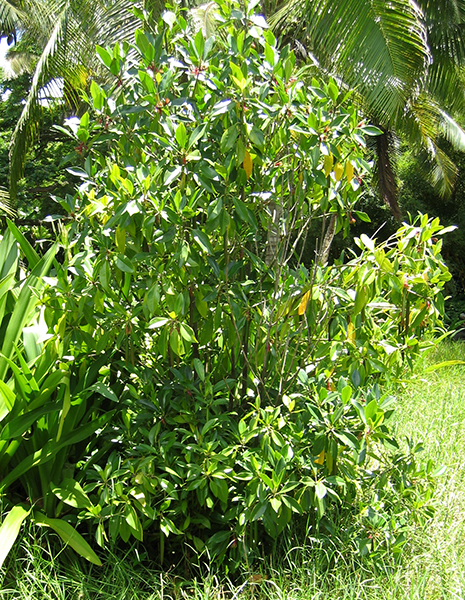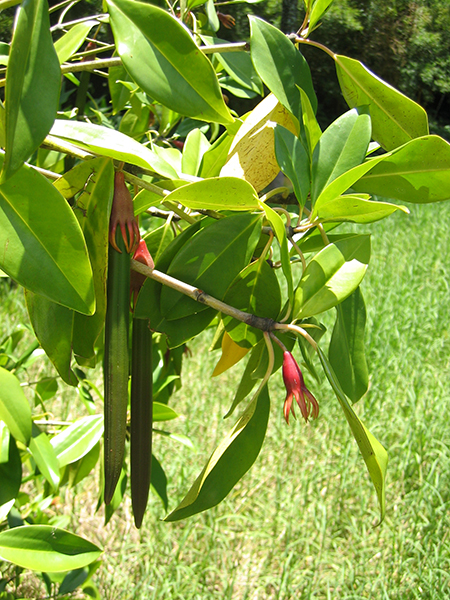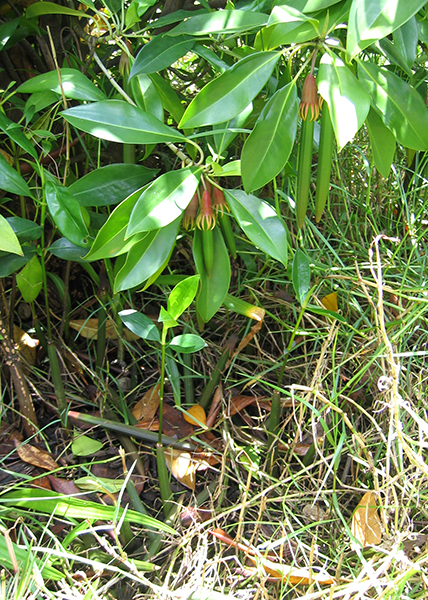Tropical Plant Database - Plant Details
Bruguiera gymnorhiza
Click on any heading above to view more information about this plant
Conservation Status
- IUCN: least concern
- USFWS: None
Family: RHIZOPHORACEAE
Genus: Bruguiera
Species: gymnorhiza
Species Author: (L.) Savigny
Vernacular: Sohmw (Kosrae name), Sohmw - Pohnpeian [A. Dores 170]
Genus: Bruguiera
Species: gymnorhiza
Species Author: (L.) Savigny
Vernacular: Sohmw (Kosrae name), Sohmw - Pohnpeian [A. Dores 170]
Bruguiera gymnorhiza grows 8 to 30 meters tall and has buttressed roots with knee-like pneumatophores which assists the tree to grow within the inter-tidal zone. The knobby pneumatophores comprise a sponge-like system of air chambers and tubes which acts as an air reservoir when the roots are submerged. The pneumatophores are covered with many lenticels, which allow air but not water to enter the root. The bark is brown to almost black and deeply fissured. The leaves are opposite, blade elliptic-oblong, leathery with stipules often reddish. The flower (1 per leaf angle) is 2.5 to 4 cm long with a greenish to red calyx having 10 - 14 deeply divided lobes. The corolla is orange also having 10 - 14 petal lobes about 12 mm long. The seed germinates on the parent tree and is technically a seedling when it falls off the tree.
(Peter K L Ng and N Sivasothi. 1999. A Guide to the Mangroves of Singapore I: The Ecosystem and Plant Diversity.)
(Michael Mastaller, Michael. 1997. Mangroves: The Forgotten Forest Between Land and Sea.)
(Peter K L Ng and N Sivasothi. 1999. A Guide to the Mangroves of Singapore I: The Ecosystem and Plant Diversity.)
(Michael Mastaller, Michael. 1997. Mangroves: The Forgotten Forest Between Land and Sea.)
The bark is astringent and used to treat malaria (in Cambodia), cure fish poisoning (in Marshall Islands), treat diarrhea and fever (in Indonesia). Elsewhere the fruit is used to treat eye problems and scrapped skin of the fruit to stop bleeding. The fruit may also be chewed as a betel nut substitute. The leaves are used to control blood pressure (in India).
(Peter K L Ng and N Sivasothi. 1999. A Guide to the Mangroves of Singapore I: The Ecosystem and Plant Diversity.)
(Michael Mastaller, Michael. 1997. Mangroves: The Forgotten Forest Between Land and Sea.)
(Peter K L Ng and N Sivasothi. 1999. A Guide to the Mangroves of Singapore I: The Ecosystem and Plant Diversity.)
(Michael Mastaller, Michael. 1997. Mangroves: The Forgotten Forest Between Land and Sea.)
The timber is heavy and tough, but has straight fibers and a fine grain.
This makes it hard to work with, but valuable as house posts, pilings, telephone poles, heavy pillars and beams, and other construction. It is commercially planted in Indonesia, Sabah and Sarawak to produce wood chips that are turned into paper pulp or to produce rayon fabric. It is also favoured as firewood and for conversion into charcoal as it produces the most heat among mangrove woods.
A similar species (B. sexangula) was introduced to the Hawaiian Islands, where the colorful orange flower is now used to make flower garlands (lei). In the Marshall Islands, the bark is used to make rope for fishing nets. The seedlings are used to produce a dye that does not bleed in water. In Tonga, Fiji and Samoa the bark of this species is used to produce a brown dye for "tapa" bark cloth. In Southeast Asia, the tree is one of the traditional dyes (orange-red color) used in batik making.
(Peter K L Ng and N Sivasothi. 1999. A Guide to the Mangroves of Singapore I: The Ecosystem and Plant Diversity.)
(Michael Mastaller, Michael. 1997. Mangroves: The Forgotten Forest Between Land and Sea.)
This makes it hard to work with, but valuable as house posts, pilings, telephone poles, heavy pillars and beams, and other construction. It is commercially planted in Indonesia, Sabah and Sarawak to produce wood chips that are turned into paper pulp or to produce rayon fabric. It is also favoured as firewood and for conversion into charcoal as it produces the most heat among mangrove woods.
A similar species (B. sexangula) was introduced to the Hawaiian Islands, where the colorful orange flower is now used to make flower garlands (lei). In the Marshall Islands, the bark is used to make rope for fishing nets. The seedlings are used to produce a dye that does not bleed in water. In Tonga, Fiji and Samoa the bark of this species is used to produce a brown dye for "tapa" bark cloth. In Southeast Asia, the tree is one of the traditional dyes (orange-red color) used in batik making.
(Peter K L Ng and N Sivasothi. 1999. A Guide to the Mangroves of Singapore I: The Ecosystem and Plant Diversity.)
(Michael Mastaller, Michael. 1997. Mangroves: The Forgotten Forest Between Land and Sea.)
The oriental mangrove is distributioned from tropical east Africa, through the Indian Ocean, Southeast Asia north to the Ryukyus, Australia, Micronesia and as far east as Samoa.
(Peter K L Ng and N Sivasothi. 1999. A Guide to the Mangroves of Singapore I: The Ecosystem and Plant Diversity.)
(Michael Mastaller, Michael. 1997. Mangroves: The Forgotten Forest Between Land and Sea.)
(Peter K L Ng and N Sivasothi. 1999. A Guide to the Mangroves of Singapore I: The Ecosystem and Plant Diversity.)
(Michael Mastaller, Michael. 1997. Mangroves: The Forgotten Forest Between Land and Sea.)
Leaves and peeled seedlings are soaked, boiled and eaten. Seedlings are a food source in Papua New Guinea, but eaten only in times of famine. Seedlings may be added to betel nut as an astringent. Seedlings are also made into a sweetmeat: they are sliced, soaked to leach out the tannins, then ground into a paste. The bark may be used to flavor fish.
(Peter K L Ng and N Sivasothi. 1999. A Guide to the Mangroves of Singapore I: The Ecosystem and Plant Diversity.)
(Michael Mastaller, Michael. 1997. Mangroves: The Forgotten Forest Between Land and Sea.)
(Peter K L Ng and N Sivasothi. 1999. A Guide to the Mangroves of Singapore I: The Ecosystem and Plant Diversity.)
(Michael Mastaller, Michael. 1997. Mangroves: The Forgotten Forest Between Land and Sea.)
In Singapore, Bruguiera gymnorhiza is listed as a rare species. Unlike some mangroves, Bruguiera does not regenerate easily from branch cuttings as new growth appears only from branch tips. Thus, careless harvesting of branches can damage or kill the tree.
It is the most widely distributed species of the mangrove family. It grows best in well-aerated soil with some freshwater, which are typical conditions found towards the back mangrove. It is among the tallest and longest lived mangroves reaching up to 36 m, but in Singapore it rarely exceeds 15 m.
(Peter K L Ng and N Sivasothi. 1999. A Guide to the Mangroves of Singapore I: The Ecosystem and Plant Diversity.)
(Michael Mastaller, Michael. 1997. Mangroves: The Forgotten Forest Between Land and Sea.)
(Information for this species compiled and recorded by Camelia Cirnaru, NTBG Consultant.)
It is the most widely distributed species of the mangrove family. It grows best in well-aerated soil with some freshwater, which are typical conditions found towards the back mangrove. It is among the tallest and longest lived mangroves reaching up to 36 m, but in Singapore it rarely exceeds 15 m.
(Peter K L Ng and N Sivasothi. 1999. A Guide to the Mangroves of Singapore I: The Ecosystem and Plant Diversity.)
(Michael Mastaller, Michael. 1997. Mangroves: The Forgotten Forest Between Land and Sea.)
(Information for this species compiled and recorded by Camelia Cirnaru, NTBG Consultant.)
- 085582 - collected by S. J. Whitmee in 0000
- 081223 - collected by T. Powell in 0000
- 074632 - collected by Art Whistler in 1971
- 074631 - collected by Art Whistler in 1973
- 074634 - collected by Art Whistler in 1974
- 074630 - collected by Art Whistler in 1975
- 074633 - collected by Art Whistler in 1976
- 023987 - collected by F. R. Fosberg in 1980
- 023768 - collected by F. R. Fosberg in 1980
- 023769 - collected by F. R. Fosberg in 1980
- 012138 - collected by Tim Flynn in 1989
- 074635 - collected by Art Whistler in 1991
- 021081 - collected by David H. Lorence in 1996
- 033551 - collected by Michael J. Balick in 1997
- 028752 - collected by Tim Flynn in 1999
- 043505 - collected by A. Raynor in 2001
- 052995 - collected by Michael J. Balick in 2002
- 052924 - collected by B. Ekiek in 2002
- 038717 - collected by A. Dores in 2002
- 048876 - collected by A. Dores in 2003
- 040561 - collected by David H. Lorence in 2004
- 044402 - collected by Nancy Vander Velde in 2006
- 054605 - collected by P. Emos Eperiam in 2006
- 096234 - collected by J. A. Sanney in 2007
- 062428 - collected by Steve Perlman in 2008
- 065948 - collected by David E. Brussell in 2008
- 067969 - collected by Nancy Vander Velde in 2009
- 067970 - collected by Nancy Vander Velde in 2009
- Unassigned - collected by K. R. Wood in 2010
- 092139 - collected by Gregory M. Plunkett in 2016
- 093280 - collected by Gregory M. Plunkett in 2016
- 093065 - collected by Gregory M. Plunkett in 2019
- 095002 - collected by Elliot Gardner in 2022
We currently have 33 herbarium specimens for Bruguiera gymnorhiza in our collection. Click on any specimen below to view the herbarium sheet data.
.svg)











